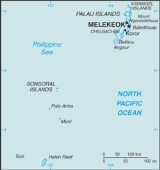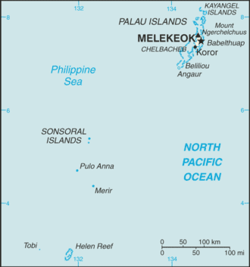
Geography of Palau
Encyclopedia

Palau
Palau , officially the Republic of Palau , is an island nation in the Pacific Ocean, east of the Philippines and south of Tokyo. In 1978, after three decades as being part of the United Nations trusteeship, Palau chose independence instead of becoming part of the Federated States of Micronesia, a...
consists of eight principal islands and more than 250 smaller ones lying roughly 500 miles southeast of the Philippines
Philippines
The Philippines , officially known as the Republic of the Philippines , is a country in Southeast Asia in the western Pacific Ocean. To its north across the Luzon Strait lies Taiwan. West across the South China Sea sits Vietnam...
. The islands of Palau constitute part of the Caroline Islands
Caroline Islands
The Caroline Islands are a widely scattered archipelago of tiny islands in the western Pacific Ocean, to the north of New Guinea. Politically they are divided between the Federated States of Micronesia in the eastern part of the group, and Palau at the extreme western end...
chain.
Location:
Oceania, group of islands in the North Pacific Ocean, southeast of the Philippines
Geographic coordinates: 7°30′N 134°30′E
Map references:
Oceania
Area:
total:
458 km²
land:
458 km²
water:
0 km²
Area - comparative:
slightly more than 2.5 times the size of Washington, DC
Land boundaries:
0 km
Coastline:
1,519 km
Maritime claims:
continental shelf:
200-m depth or to the depth of exploitation
exclusive fishing zone:
12 nm
extended fishing zone:
200 nm
territorial sea:
3 nm
Climate:
wet season May to November; hot and humid
Terrain:
varying geologically from the high, mountainous main island of Babeldaob
Babeldaob
Babeldaob is the largest island in the island nation of Palau. Its area, 331 km² , makes up over 70% of the area of the entire country, and about 30% of the population, with about 6,000 people living there...
to low, coral islands usually fringed by large barrier reefs
Elevation extremes:
lowest point:
Pacific Ocean 0 m
highest point:
Mount Ngerchelchauus 242 m (on Babeldaob)
Natural resources:
forests, minerals (especially gold), marine products, deep-seabed minerals
Land use:
arable land:
NA%
permanent crops:
NA%
permanent pastures:
NA%
forests and woodland:
NA%
other:
NA%
Irrigated land:
NA km²
Natural hazards:
typhoons (June to December)
Environment - current issues:
inadequate facilities for disposal of solid waste; threats to the marine ecosystem from sand and coral dredging, illegal fishing practices, and overfishing
Environment - international agreements:
party to:
Biodiversity
Biodiversity
Biodiversity is the degree of variation of life forms within a given ecosystem, biome, or an entire planet. Biodiversity is a measure of the health of ecosystems. Biodiversity is in part a function of climate. In terrestrial habitats, tropical regions are typically rich whereas polar regions...
, Climate Change
United Nations Framework Convention on Climate Change
The United Nations Framework Convention on Climate Change is an international environmental treaty produced at the United Nations Conference on Environment and Development , informally known as the Earth Summit, held in Rio de Janeiro from June 3 to 14, 1992...
, Climate Change-Kyoto Protocol
Kyoto Protocol
The Kyoto Protocol is a protocol to the United Nations Framework Convention on Climate Change , aimed at fighting global warming...
, Desertification
Desertification
Desertification is the degradation of land in drylands. Caused by a variety of factors, such as climate change and human activities, desertification is one of the most significant global environmental problems.-Definitions:...
, Law of the Sea
Law of the sea
Law of the sea may refer to:* United Nations Convention on the Law of the Sea* Admiralty law* The Custom of the Sea...
signed, but not ratified:
none of the selected agreements
Geography - note:
includes World War II
World War II
World War II, or the Second World War , was a global conflict lasting from 1939 to 1945, involving most of the world's nations—including all of the great powers—eventually forming two opposing military alliances: the Allies and the Axis...
battleground of Peleliu
Peleliu
Peleliu is an island in the island nation of Palau. Peleliu forms, along with two small islands to its northeast, one of the sixteen states of Palau. It is located northeast of Angaur and southwest of Koror....
and world-famous rock islands; archipelago of six island groups totaling over 200 islands in the Caroline chain
Extreme points
This is a list of the extreme points of PalauPalau
Palau , officially the Republic of Palau , is an island nation in the Pacific Ocean, east of the Philippines and south of Tokyo. In 1978, after three decades as being part of the United Nations trusteeship, Palau chose independence instead of becoming part of the Federated States of Micronesia, a...
, the points that are farther north, south, east or west than any other location.
- Northern-most point – Ngaruangel Reef, KayangelKayangelKayangel is the northernmost state of Palau north of Koror. The land area is about . The population is 138 . The state consists of three atolls in different states of development:-Kayangel Atoll:...
state* - Eastern-most point – Kayangel islet, KayangelKayangelKayangel is the northernmost state of Palau north of Koror. The land area is about . The population is 138 . The state consists of three atolls in different states of development:-Kayangel Atoll:...
state - Southern-most point – Round Rock, Helen Reef, HatohobeiHatohobeiTobi Island, or Hatohobei , is the southernmost of Palau's sixteen states, consisting of Tobi Island and uninhabited Helen Reef. The total land area is about 0.88 km²...
state - Western-most point - Tobi Island, HatohobeiHatohobeiTobi Island, or Hatohobei , is the southernmost of Palau's sixteen states, consisting of Tobi Island and uninhabited Helen Reef. The total land area is about 0.88 km²...
state
- *Note: if submerged reefs are included then Velasco reef is Palau's northern-most point
- See also : PalauPalauPalau , officially the Republic of Palau , is an island nation in the Pacific Ocean, east of the Philippines and south of Tokyo. In 1978, after three decades as being part of the United Nations trusteeship, Palau chose independence instead of becoming part of the Federated States of Micronesia, a...

